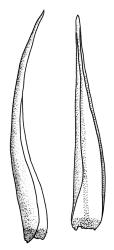No attempt is made here to provide a generic description of this large genus, which is diverse in the northern hemisphere. Dicranum, in its modern sense, is represented in N.Z. by only a single species. The members of Dicranum are often robust cushion-forming plants with lanceolate and often secund leaves. Crum & Anderson (1981, p. 196) emphasise the unevenly split and vertically pitted-striolate peristome teeth (the members of the genus are thus sometimes referred to as "fork mosses") and slenderly lanceolate leaves with differentiated alar cells and "well-defined stereids and guide cells" as features characterising the genus. More detailed generic descriptions can be found in the northern hemisphere Floras cited below.
I have elsewhere (Fife 1995) included N.Z. species of Dicranoloma in a broadly conceived Dicranum. A similar concept of Dicranum was employed by Norris & Koponen (1990) in their treatment of the Dicranaceae from the Huon Peninsula, P.N.G. However, Klazenga (1999) has considered the distinction between Dicranum and Dicranoloma using morphological characters. He concluded that both Dicranum and Dicranoloma are paraphyletic as they are traditionally circumscribed, and that the "best solution would be to split these large paraphyletic genera 'into smaller, monophyletic groups', but that the results of his analysis were insufficiently conclusive to support this radical taxonomic change". Klazenga’s (1999, 2003) views on the distinction between Australasian Dicranum and Dicranoloma are adapted here. Alar cells in N.Z. material of Dicranum leioneuron (and representative northern hemisphere species) are partially bistratose, in contrast to the unistratose alar cells in Australasian species of Dicranoloma. According to Klazenga (1999, p. 23), "all the species of Dicranum that can be possibly confused with Dicranoloma have multi-layered alar cells". A cross-section of the alar group under the stereoscope is usually required to demonstrate this feature convincingly. In a N.Z. context the absence of a differentiated leaf border or limbidium in D. leioneuron also provides a helpful distinction.
The presence of a conspicuous group of non-pigmented, non-porose, and rather thin-walled cells at the leaf base (between the alar group and the costal base) is also a constant feature of N.Z. Dicranum; a basal group of non-pigmented cells does not occur in N.Z. species of Dicranoloma. The presence of such a cell group is widespread in Dicranum, but it is unclear to me whether the presence/absence of a non-pigmented basal group distinguishes Dicranum and Dicranoloma in all parts of their ranges.
Dicranum, as it is circumscribed by modern authors, is a genus of more than 50 species predominantly distributed in the northern hemisphere. Smith (2004) treated 14 species for the British Isles; Crum & Anderson (1981) 15 species for eastern North America; and Noguchi (1987–1994) approximately 20 species for Japan.
| Category | Number |
|---|---|
| Indigenous (Non-endemic) | 1 |
| Total | 1 |
Dicranum aucklandicum Dixon is considered here a synonym of Kiaeria pumila (Mitt.) Ochyra.
Dicranum scoparium Hedw. The N.Z. material treated under this name by Sainsbury (1955) is here considered as D. leioneuron.
Dicranum trichopodum Mitt. in Hook.f. is treated here as Holomitrium trichopodum (Mitt.) Klazenga.




